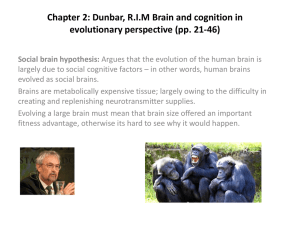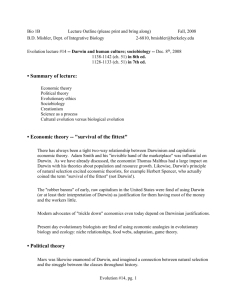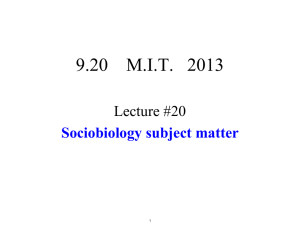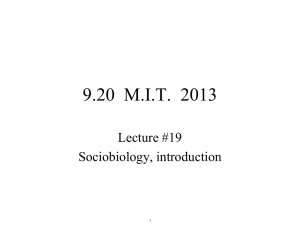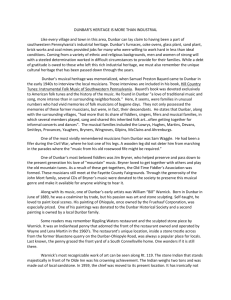Review of Clive Gamble, John Gowlett and Robin Dunbar Thinking Big
advertisement
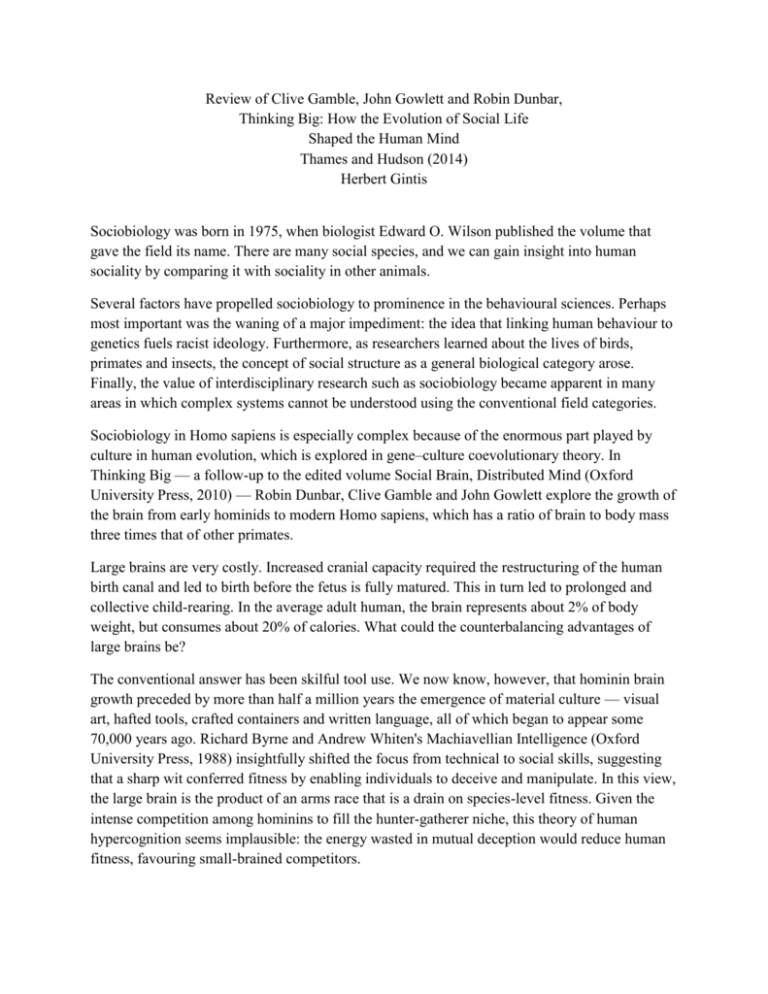
Review of Clive Gamble, John Gowlett and Robin Dunbar, Thinking Big: How the Evolution of Social Life Shaped the Human Mind Thames and Hudson (2014) Herbert Gintis Sociobiology was born in 1975, when biologist Edward O. Wilson published the volume that gave the field its name. There are many social species, and we can gain insight into human sociality by comparing it with sociality in other animals. Several factors have propelled sociobiology to prominence in the behavioural sciences. Perhaps most important was the waning of a major impediment: the idea that linking human behaviour to genetics fuels racist ideology. Furthermore, as researchers learned about the lives of birds, primates and insects, the concept of social structure as a general biological category arose. Finally, the value of interdisciplinary research such as sociobiology became apparent in many areas in which complex systems cannot be understood using the conventional field categories. Sociobiology in Homo sapiens is especially complex because of the enormous part played by culture in human evolution, which is explored in gene–culture coevolutionary theory. In Thinking Big — a follow-up to the edited volume Social Brain, Distributed Mind (Oxford University Press, 2010) — Robin Dunbar, Clive Gamble and John Gowlett explore the growth of the brain from early hominids to modern Homo sapiens, which has a ratio of brain to body mass three times that of other primates. Large brains are very costly. Increased cranial capacity required the restructuring of the human birth canal and led to birth before the fetus is fully matured. This in turn led to prolonged and collective child-rearing. In the average adult human, the brain represents about 2% of body weight, but consumes about 20% of calories. What could the counterbalancing advantages of large brains be? The conventional answer has been skilful tool use. We now know, however, that hominin brain growth preceded by more than half a million years the emergence of material culture — visual art, hafted tools, crafted containers and written language, all of which began to appear some 70,000 years ago. Richard Byrne and Andrew Whiten's Machiavellian Intelligence (Oxford University Press, 1988) insightfully shifted the focus from technical to social skills, suggesting that a sharp wit conferred fitness by enabling individuals to deceive and manipulate. In this view, the large brain is the product of an arms race that is a drain on species-level fitness. Given the intense competition among hominins to fill the hunter-gatherer niche, this theory of human hypercognition seems implausible: the energy wasted in mutual deception would reduce human fitness, favouring small-brained competitors. In Thinking Big, Dunbar, Gamble and Gowlett supply a more credible theory with their “social brain hypothesis”. They describe the major findings of the ambitious 7-year project 'Lucy to Language: The Archaeology of the Social Brain', which involved more than 30 researchers and 5 UK universities, and was backed by the British Academy, the national funding body for humanities and social sciences. The authors show that there is a strong correlation between relative neocortex volume and mean social-group size in monkeys, apes and humans. They attribute this to the fact that the complexity of group interactions increases with group size. A large brain gives individuals the means to forge strong social ties that enhance their personal fitness and the group's social cohesion; in particular, a large neocortex supports a “theory of mind”, whereby individuals can form mental representations of the beliefs and intentions of others. This enables them to enter into complex agreements and coalitions, and to track multiple social relationships through time and space. Social Brain, Distributed Mind is rather more detailed. It brings together an array of archaeologists, anthropologists, geographers, psychologists, palaeontologists, historians and philosophers involved in Lucy to Language, who together construct a plausible “cognitive anthropology” that defends the social brain hypothesis, while exploring the idea that the human mind is not confined to individual brains, but lives in a social network of minds across which cognition is distributed. They thus handle the problem of brain growth long preceding the emergence of material culture. The contributors argue that long before material culture, early hominins developed a “material memory system” in the form of tokens and containers. This linked the mental power of many individuals, and led to a transition from knowledge acquisition and learning based on personal discovery to cognition based on social interaction and sharing. With distributed cognition, knowledge lies not only in the individual, but also in the social roles and iconic artefacts that link minds. For instance, humans have formed 'fission–fusion' social groupings in which kin relationships are maintained across subgroups, both males and females migrate to marry, and complex, powerful, fitness-enhancing familial alliances are sustained. How plausible is the idea that we have big brains because we evolved to live in large groups, putting heavy cognitive demands on our ability to forge close social bonds with large numbers of individuals? My own view is that hunting required a high level of coordinated decision-making, and that the presence of lethal weapons undermined our ape ancestors' characteristic socialdominance hierarchy, which was based on the physical prowess of the alpha male. This created a leadership void that could be filled not by appeal to physical strength, but rather by social persuasiveness and then a subtle ability to form effective coalitions. The result was a political structure in which linguistic facility and cognitive skills were rewarded with enhanced reproductive fitness. The social brain, then, helped our ancestors to operate successfully in a proto-democratic framework.






